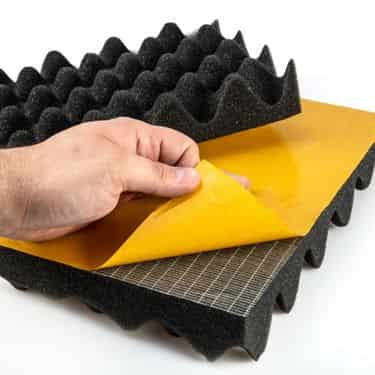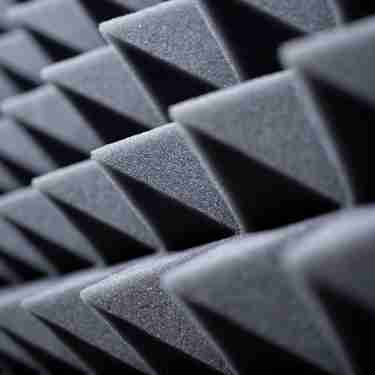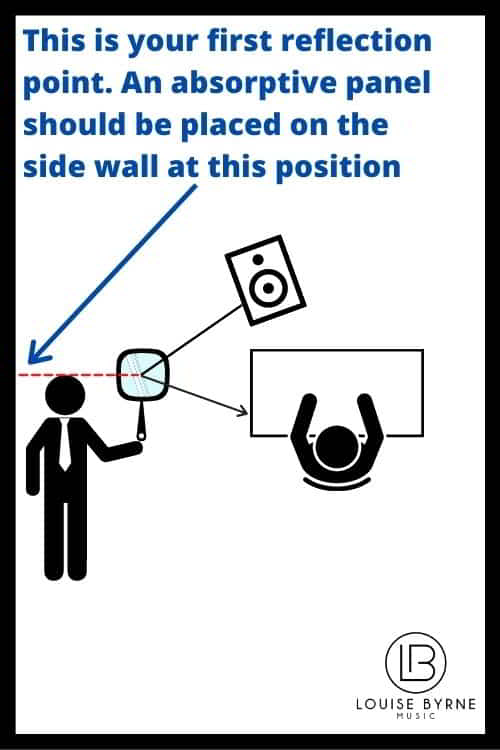Do you need acoustic foam? That is a question that many business owners and homeowners ask themselves. The answer is not always straightforward, as there are many factors to consider.
Many DIY content creators, including music producers, YouTubers, and streamers on Twitch, wonder if they even need acoustic foam. It looks cool, but does it actually help your sound?
As a general rule, acoustic foam will improve the sound quality of your home recordings if you choose the correct type of foam and positioned it in the optimum place within a room. You must take care and consideration when positioning the foam to get an audible result.
As there is not a “one size fits all” approach, acoustic foam often gets a bad reputation in online discussions, as results will vary between studios.
In this article I will cover:
- What does acoustic foam do?
- Does acoustic foam really work?
- Do you need acoustic foam?
- Why is acoustic foam shaped?
- How do you choose acoustic foam?
- Will any type of foam work?
- Where should I place acoustic foam?
- Can egg cartons be used as soundproofing?
- What is an acoustic diffuser?
- Is acoustic foam good for soundproofing?

What Does Acoustic Foam Do?
If you’re looking to acoustically treat your home recording studio or office studio, acoustic foam can be an affordable and good solution.
Acoustic foam is used to absorb sound and control reverberation. It is usually placed in areas of a room where sound is bouncing around and creating echoes, such as corners and behind furniture. Acoustic foam can help to improve the clarity of sound and reduce background noise.
Acoustic treatment is the process of using various materials, such as acoustic foam, to improve the internal room acoustics of a recording or listening space.
Sound travels in waves and as you listen to or record music, the sound is constantly bouncing off the internal walls of your studio, reflecting off surfaces and interfering with each other.
Sometimes, these internal sound wave reflections can interfere with each other and create problems for content creators.
When mixing, recording, or just listening to audio, you want to ensure that your content sounds good. As a producer, it is hard to know if you’re hearing the true sound of your recording or if you’re hearing an effect of your room acoustics and internal sound reflection.
You might mix your content in a recording studio and it sounds great, but then you take your recording to another room and it is completely different or doesn’t sound too good at all.
So, you want your home recording studio or listening environment to be as acoustically neutral as possible.
In a perfect world, the sound in your recording studio should be as accurate to the original recording as possible, with no interference or influence from the acoustics in your room.
By using acoustic foam, you can absorb unnecessary reflections and audio reverberation, thus allowing you to hear or record your audio as clearly as possible and true to the original sound source.
Does Acoustic Foam Really Work?
The effectiveness of acoustic foam depends on several factors, such as the type of foam used, its positioning within the room, and the acoustics of the space itself.
Therefore, it is difficult to say unequivocally whether acoustic foam works as it depends on the room.
In general, it is likely to improve the sound quality of your home recordings if positioned correctly.
It is important to understand the types of acoustic foam and where to position it in order to ensure that your acoustic foam is actually working and not just looking good.
Standard “off the shelf” acoustic foam is typically good for treating the mid to high frequencies in a room if positioned well.
Acoustic foam is typically very cheap and easy to work with. It is possible to carefully position acoustic foam in your room to absorb mid to high frequencies and help create a neutral listening environment.
Acoustic foam can be glued to the walls of your studio or, if you don’t want a permanent solution, you can glue foam panels to boards and hang them just like a picture.
In addition, acoustic foam is very easy to cut, so it’s quite easy to make custom-shaped pieces for your studio
There are many types of acoustic foam on the market. Typically, the thicker the foam, the more lower frequencies it will absorb, which will remove any unwanted booming from bass.
Do You Need Acoustic Foam?
Whether you need acoustic foam depends on a variety of factors, such as the size and shape of the room, the type of activities taking place in the room and the type of foam you choose.
In general, acoustic foam will improve the sound quality of your home recordings if placed correctly.
As a general rule, if you have a lot of echo on your recordings, reverberation, or if your recordings sound like you recorded them at a distance from the microphone, then you will benefit from using acoustic foam.
Why Is Acoustic Foam Shaped?
You’ll find that most acoustic foam you buy off the shelf will have sculpted pyramids or wedges on its front face, just like the image below.

The function of these wedges and uneven surfaces on acoustic foam is to provide greater absorption of frequencies and diffuse the sound. When sound hits the foam at an angle, it has more thickness to pass through and therefore, you will get greater sound absorption.
How Do You Choose Acoustic Foam?
There are so many types of acoustic foam on the market, with different shapes and sizes, that it can be very difficult to compare and contrast acoustic foam.
When choosing acoustic foam, there are a few things to consider:
- The Type Of Foam
There are different types of acoustic foam, so you need to choose the right one for your needs.
- The Size Of Foam
Make sure to choose acoustic foam that is the right size for the space you want to treat. If it’s too small, it won’t be effective; if it’s too big, it will be difficult to position correctly.
- The Shape Of Foam
Not all acoustic foam comes in the same shape. You need to choose a shape that will fit comfortably in the space you want to treat. For example, if you’re treating a corner, choose acoustic foam that’s in the shape of a triangle.
From a technical point of view, you can carefully compare the following technical specifications of the foam:
- The Noise Reduction Coefficient
- Acoustic Coefficients
The Noise Reduction Coefficient Specification
One figure that exists to compare acoustic products is called the “Noise Reduction Coefficient” or NRC for short. This number shows the overall performance of the acoustic material.
Basically, a manufacturer will measure the reverberation room response, then add some acoustic foam, and measure how much reverb is present in the room after the acoustic foam has been added.
Then, using some fancy maths, an absorption value is calculated and rounded off to the nearest number.
This now gives us a number which tells us how well the material performed which can be used to compare different acoustic products.
Acoustic Coefficient Specification
If you have a specific frequency that you want to absorb, then you’re better off looking at the acoustic coefficients, which show the absorbent qualities of a specific material for a different frequency band.
At the end of the day, all this information is just data that can help you make a better decision.
For cheaper foam, often these technical specifications are not present.
Cheaper or generic acoustic foam will not have data included.
When picking cheaper foam, they will provide you with overall dimensions, including thickness. The thicker, the better.
If you want to get more technical with your acoustic foam selection, the best people to talk to are the manufacturers as they will know their products and will have tested how well their foam performs.
I recommend “Auralex Acoustics” as they specialise in acoustic foam products, have fantastic technical data and always produce great quality products.
Will Any Type Of Foam Work?
In theory, any form or soft surface will act as an acoustic absorber.
To save money, many creators have used foam mattresses, dense packing or foam pillows to try to acoustically treat the room.
As mentioned, any soft material will absorb high frequencies, so in theory, these alternatives will work. However, they don’t compare to the performance of the specifically designed acoustic foam.
In addition, true acoustic foam is made from an open cell material. “Open cell” means that there are holes in the material that allow sound energy to easily pass through – when sound passes through the material, it is absorbed.
Where Should I Place Acoustic Foam?
In order to get the most out of your acoustic foam, where you position it in your studio is essential.
I’m afraid that just purchasing acoustic foam and sticking it on the wall will not be effective unless you get really lucky and accidentally stick it in the right place!
Acoustic treatment is considered more of an art than a science. However, there are some basic rules you can follow to help you place your acoustic foam in a suitable location.
Acoustic Foam Placement: The First Reflection Point Method
Typically, acoustic foam is used to absorb high frequencies and should be positioned at the first reflection point in relation to your studio monitors,
There is an easy method you can use to find the first reflection point.
Ensure your studio monitors are in their permanent position and sit in front of your monitors in your usual listening position – just as if you’re going to work in your studio for the day.
For the next part, you are going to need an assistant.
While sitting in your listening position, ask your assistant to hold a mirror against the wall on your left, roughly centred between your listening position and the speakers.
Here is an image to demonstrate.

Now ask your assistant to move the mirror along the wall until you can see the nearest studio monitor reflected in the glass. – this location is your point of first reflection. Your acoustic foam should be placed at this point.
Repeat this procedure for both monitors, then do the same for the right wall.
Here is a video to show the first reflection point method.
As well as adding acoustic treatment to the side walls of your studio, it’s also a good idea to add acoustic treatment to the wall behind you.
An acoustic diffuser or acoustic foam with a particularly jagged face is useful here.
In addition, place some acoustic foam on the wall behind your studio speakers. By treating the wall behind your studio speakers, you will improve reflections and imaging of sound waves hitting off the back wall at the rear of your speakers.
“Off-the-shelf” acoustic foam is typically very good for absorbing mid to high frequencies, but if you want to absorb and manage lower frequencies, you can use double layers of foam to increase the absorption thickness.
Alternatively, you could mount foam panels with an air gap between them.
By adding an air gap between your acoustic panels and foam sheets, you will create a better absorption result and absorb more lower frequencies.
Can Egg Cartons Be Used As Soundproofing?
At some point, someone got the idea of sticking egg cartons to a wall of a studio to soundproof or acoustically treat the studio.
This became incredibly popular, as, compared to the price of acoustic foam in the past, egg cartons were very cheap.
Although I could not track down the original source of the “egg carton trick”, I think it is fair to assume that some high-profile producer or artist must have used it in order for it to gain the popularity status that it has.
Egg cartons will not work in soundproofing a room. The thin material will not absorb sound.
Egg cartons have an uneven surface that can assist with handling internal room reflections similar to the principles of an acoustic diffuser. However, the benefits are very limited.
It is also important to note that egg cartons are a fire risk, therefore unsuitable for business and home use. Acoustic foam is a better solution.
What Is An Acoustic Diffuser?
An acoustic diffuser is a rough or uneven surface that helps scatter sound waves throughout your room. Acoustic diffusers are excellent for room acoustic treatment as they help to control internal room reflections.
Using diffusers has the benefit of controlling and handling unwanted studio room sound issues such as internal room reflections, echos/reverb and standing waves.
These unwanted room acoustics could make you hear a sound on a recording that isn’t truly there.
For example, imagine you are mixing an audio track and it sounds really bass-heavy. As a producer, you will most likely apply EQ (equalisation) to remove the muddy bass sound.
But, imagine that the bass sound is not actually on the recording, but is being created by a build-up of sound reflections in your room. Your studio is giving the impression that there is a lot of bass.
Once you take your mix and listen in another room, you may have found that you have removed too much bass and the audio mix now sounds too “tinny” and lacks bass.
Therefore, it is important to control internal room acoustics when mixing, so you are mixing the true recorded audio and not being influenced by “false” effects created by room acoustics.
This is where acoustic diffusers can help as, if used correctly, they will scatter sound waves throughout your room, creating balanced room acoustics.
Acoustic diffusers are important but can be very expensive.
Personally, I get around the high acoustic diffuser cost in my home studio by using a bookcase as a diffuser.
Place a full bookcase in your studio, with the books uneven to create a rough and uneven surface. As sound waves hit the uneven surface of the bookcase, they will scatter the sound waves around the room (i.e. diffused).
True acoustic diffusers are carefully designed using mathematical equations so a DIY solution will never be as effective, but are good enough for a studio owner on a budget.
Is Acoustic Foam Good For Soundproofing?
Soundproofing is the process of making a room or space impervious to sound. This can be done by adding insulation to the walls, ceilings and floors, or by using sound-absorbing materials, such as acoustic foam.
Acoustic foam does not block sound, so is not a good solution for soundproofing on its own.
Acoustic foam can help to improve the sound quality of your home recordings if positioned correctly by helping sound move better within a room, but it does not block sound and therefore is not good for soundproofing, where the aim is to create a barrier to sound.
Final Thoughts
Often acoustic foam has a bad reputation, particularly in internet discussions and online.
Many content creators do not believe in the need for acoustic foam, as they cannot easily hear the benefit.
Complex mathematics and physics are used to carefully position acoustic foam, however, as every room varies in shape and size, there is not a “one size fits all” solution, so acoustic treatment is often seen as an art form more than a science.
This can cause conflict between sound engineers, as some engineers can get a significant benefit from acoustic foam and others will fail to see the effect.
At the end of the day, it’s all about placing your acoustic foam in the best position to absorb stray mid to high frequencies. Do that well and your acoustic foam will help.
